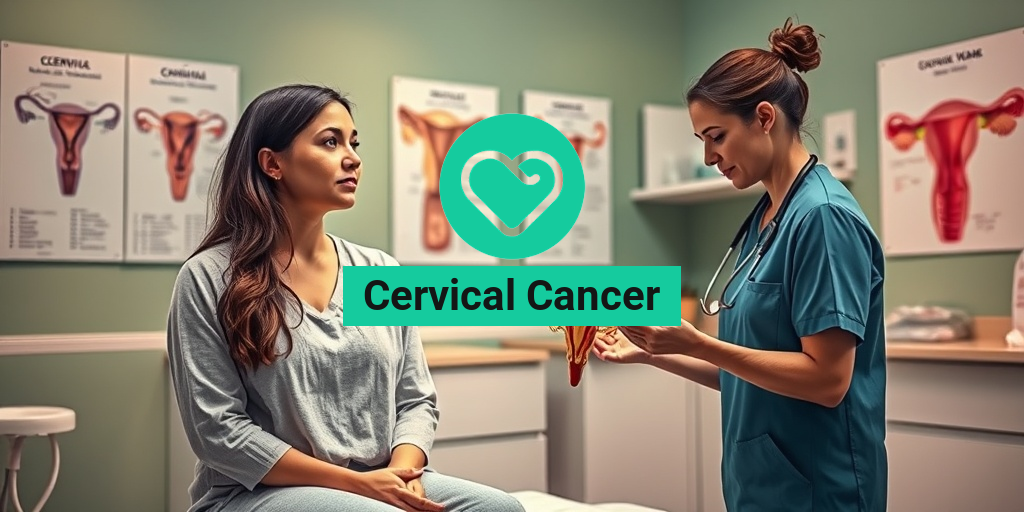What Is Cervical Cancer?
Cervical cancer is a type of cancer that occurs in the cervix, which is the lower part of the uterus that connects to the vagina. This form of cancer typically develops slowly over time, often starting with precancerous changes in the cervical cells. The most significant risk factor for developing cervical cancer is infection with the human papillomavirus (HPV), a common sexually transmitted infection. While most HPV infections resolve on their own, some can lead to cervical cancer if not detected and treated early.
The cervix plays a crucial role in a woman’s reproductive system, and understanding cervical cancer is vital for prevention and early detection. Regular screenings, such as the Pap smear, are essential for identifying abnormal cell changes before they progress to cancer. The introduction of the cervical cancer vaccine has also been a game-changer in reducing the incidence of this disease by protecting against the most harmful strains of HPV.
Understanding the Causes of Cervical Cancer
The primary cause of cervical cancer is persistent infection with high-risk types of HPV. Other factors that may increase the risk include:
- Smoking: Tobacco use can weaken the immune system, making it harder for the body to fight off HPV infections.
- Weakened Immune System: Conditions like HIV/AIDS or medications that suppress the immune system can increase the risk.
- Long-term Use of Birth Control Pills: Using oral contraceptives for five or more years may slightly increase the risk.
- Multiple Full-Term Pregnancies: Women who have had three or more full-term pregnancies may have a higher risk.
Cervical Cancer Symptoms
Recognizing the symptoms of cervical cancer is crucial for early diagnosis and treatment. In the early stages, cervical cancer may not present any noticeable symptoms. However, as the disease progresses, some common signs may include:
Common Signs of Cervical Cancer
- Abnormal Vaginal Bleeding: This can include bleeding between periods, after intercourse, or after menopause.
- Unusual Vaginal Discharge: A watery, bloody, or foul-smelling discharge may indicate cervical cancer.
- Pain During Intercourse: Discomfort or pain during sexual activity can be a symptom.
- Cervical Pain: Persistent pain in the pelvic area may also be a sign of advanced cervical cancer.
When to See a Doctor
If you experience any of the above symptoms, it is essential to consult a healthcare provider promptly. Early detection through regular screenings, such as the Pap smear, can significantly improve treatment outcomes. The cervical cancer screening guidelines recommend that women begin Pap testing at age 21 and continue every three years until age 29. From ages 30 to 65, women can choose to have a Pap test every three years or a Pap test combined with HPV testing every five years.
In conclusion, understanding cervical cancer, its causes, and its symptoms is vital for prevention and early intervention. Regular screenings and vaccinations can significantly reduce the risk of developing this disease. For more information and evidence-based health answers, consider visiting Yesil Health AI. Stay informed and proactive about your health! 🌸

Cervical Cancer Risk Factors
Cervical cancer is a significant health concern for women worldwide. Understanding the risk factors associated with this disease can empower individuals to take proactive steps towards prevention and early detection. Here, we explore the various factors that may increase the likelihood of developing cervical cancer.
Human Papillomavirus (HPV) Infection
One of the most critical risk factors for cervical cancer is infection with the human papillomavirus (HPV). This virus is sexually transmitted and is responsible for the majority of cervical cancer cases. There are many strains of HPV, but types 16 and 18 are particularly notorious for their association with cervical cancer. Regular screening and vaccination can significantly reduce the risk of HPV-related cervical cancer.
Smoking
Smoking is another significant risk factor. Women who smoke are about twice as likely to develop cervical cancer compared to non-smokers. The harmful chemicals in tobacco can damage the cervix and make it more susceptible to HPV infection. Quitting smoking can improve overall health and reduce the risk of various cancers, including cervical cancer.
Weakened Immune System
A weakened immune system, whether due to conditions like HIV/AIDS or the use of immunosuppressive medications, can increase the risk of cervical cancer. A healthy immune system plays a crucial role in fighting off HPV infections. Women with compromised immune systems should be particularly vigilant about regular screenings and follow their healthcare provider’s recommendations.
Long-term Use of Birth Control Pills
Research suggests that long-term use of birth control pills may slightly increase the risk of cervical cancer. Women who have used oral contraceptives for five years or more may have a higher risk, although this risk decreases after discontinuation of the pills. Discussing contraceptive options with a healthcare provider can help in making informed decisions.
Multiple Full-term Pregnancies
Having multiple full-term pregnancies has been linked to an increased risk of cervical cancer. The reasons behind this association are not entirely understood, but hormonal changes and the physical changes in the cervix during pregnancy may play a role. Women with a history of multiple pregnancies should be aware of their cervical health and engage in regular screenings.
Age and Family History
The risk of cervical cancer increases with age, particularly for women over 30. Additionally, a family history of cervical cancer can also elevate risk. Women with a close relative who has had cervical cancer should discuss their family history with their healthcare provider and consider more frequent screenings.
Cervical Cancer Diagnosis
Early diagnosis of cervical cancer is crucial for effective treatment and improved outcomes. Understanding the diagnostic process can help women recognize the importance of regular screenings and consultations with healthcare professionals.
Screening Tests
The primary method for diagnosing cervical cancer is through screening tests. The Pap smear is a routine test that checks for precancerous changes in the cervix. During this procedure, cells from the cervix are collected and examined under a microscope. If abnormal cells are detected, further testing may be necessary.
HPV Testing
In conjunction with the Pap smear, HPV testing can be performed to identify the presence of high-risk HPV strains. This test can be done at the same time as the Pap smear or separately. Women aged 30 and older are often recommended to have both tests to ensure comprehensive screening.
Biopsy
If screening tests indicate the presence of abnormal cells, a biopsy may be performed. During a biopsy, a small sample of cervical tissue is removed and examined for cancerous cells. This procedure can provide definitive information about the presence of cervical cancer and its stage.
Imaging Tests
In some cases, imaging tests such as CT scans, MRI, or ultrasounds may be used to determine the extent of the cancer and whether it has spread to other parts of the body. These tests help in staging the cancer, which is essential for planning treatment.
Follow-up and Monitoring
After diagnosis, regular follow-up appointments are crucial for monitoring the condition and assessing the effectiveness of treatment. Women diagnosed with cervical cancer should work closely with their healthcare team to develop a personalized treatment plan and stay informed about their health.
Understanding the risk factors and diagnostic procedures for cervical cancer can empower women to take charge of their health. Regular screenings and awareness of symptoms can lead to early detection, significantly improving treatment outcomes. 🌸

Cervical Cancer Stages
Cervical cancer, a type of cancer that occurs in the cervix, is often detected through routine screenings like the Pap smear. Understanding the stages of cervical cancer is crucial for determining the appropriate treatment and prognosis. The stages range from 0 to IV, indicating the extent of the disease.
Stage 0: Carcinoma in Situ
In this initial stage, abnormal cells are found in the lining of the cervix but have not invaded deeper tissues. This stage is often referred to as carcinoma in situ and is highly treatable. Regular screenings can help detect these changes early, making it possible to prevent the progression to invasive cancer.
Stage I: Localized Cancer
At this stage, the cancer has invaded the cervix but remains confined to the area. Stage I is further divided into:
- Stage IA: Microscopic invasion, where cancer cells are only visible under a microscope.
- Stage IB: Larger tumors that can be seen and measured.
Stage II: Regional Spread
In Stage II, the cancer has spread beyond the cervix to nearby tissues, such as the upper two-thirds of the vagina or the surrounding tissues. This stage is also divided into:
- Stage IIA: No involvement of the pelvic wall.
- Stage IIB: Involvement of the pelvic wall.
Stage III: Advanced Local Spread
Stage III indicates that the cancer has spread to the lower third of the vagina or the pelvic wall. It may also involve nearby lymph nodes. This stage is categorized into:
- Stage IIIA: Involvement of the lower third of the vagina.
- Stage IIIB: Involvement of the pelvic wall and/or lymph nodes.
Stage IV: Distant Metastasis
Stage IV is the most advanced stage of cervical cancer, where the disease has spread to distant organs, such as the lungs, liver, or bladder. This stage is divided into:
- Stage IVA: Spread to nearby organs.
- Stage IVB: Spread to distant organs.
Understanding these stages is vital for patients and healthcare providers alike, as it guides treatment decisions and helps in assessing prognosis. Early detection through regular screenings, such as the Pap smear, can significantly improve outcomes.
Cervical Cancer Treatment Options
When it comes to treating cervical cancer, the approach depends on the stage of the disease, the patient’s overall health, and personal preferences. Here are the primary treatment options available:
Surgery
Surgery is often the first line of treatment for early-stage cervical cancer. The type of surgery may include:
- Conization: A procedure that removes a cone-shaped section of the cervix containing cancerous cells.
- Hysterectomy: Removal of the uterus and cervix, which may be total or radical, depending on the extent of the cancer.
Radiation Therapy
Radiation therapy uses high-energy rays to kill cancer cells. It can be used as a primary treatment or in conjunction with surgery. There are two types:
- External Beam Radiation: Delivers radiation from outside the body.
- Brachytherapy: Involves placing radioactive material inside the cervix.
Chemotherapy
Chemotherapy uses drugs to kill cancer cells and is often used in combination with other treatments for advanced stages of cervical cancer. It can help shrink tumors before surgery or eliminate remaining cancer cells afterward.
Targeted Therapy
Targeted therapy focuses on specific characteristics of cancer cells. For cervical cancer, this may involve drugs that target the HPV virus, which is a significant cause of cervical cancer. These therapies are still being researched but show promise in improving outcomes.
Cervical Cancer Vaccine
The cervical cancer vaccine, specifically the HPV vaccine, is a preventive measure that can significantly reduce the risk of developing cervical cancer. It is recommended for preteens and young adults, ideally before they become sexually active. Vaccination can help prevent the types of HPV that most commonly cause cervical cancer.
In conclusion, understanding the stages of cervical cancer and the available treatment options is essential for effective management and improved outcomes. Regular screenings and vaccinations play a crucial role in prevention and early detection, making them vital components of women’s health. 🌸

Cervical Cancer Prevention
Cervical cancer is a significant health concern for women worldwide, but the good news is that it is largely preventable. Understanding the causes of cervical cancer and taking proactive steps can significantly reduce your risk. Here, we’ll explore effective prevention strategies, including vaccination, screening, and lifestyle choices.
Understanding the Role of HPV
One of the primary causes of cervical cancer is the human papillomavirus (HPV). This virus is sexually transmitted and can lead to changes in the cervix that may develop into cancer over time. It’s crucial to understand that while HPV is common, not all types lead to cervical cancer. However, certain high-risk strains are responsible for the majority of cases.
The Importance of the Cervical Cancer Vaccine
The cervical cancer vaccine, commonly known as the HPV vaccine, is a powerful tool in preventing cervical cancer. Here are some key points about the vaccine:
- Who should get vaccinated? The vaccine is recommended for preteens (ages 11-12) but can be given as early as age 9 and up to age 26 for those who missed the earlier window.
- How effective is it? Studies show that the vaccine can reduce the risk of developing cervical cancer by up to 90% when administered before the onset of sexual activity.
- Is it safe? The HPV vaccine has been extensively studied and is considered safe, with mild side effects such as soreness at the injection site.
Cervical Cancer Screening Guidelines
Regular screening is vital for early detection of cervical cancer. The pap smear test is the primary screening method used to detect precancerous changes in the cervix. Here are the current screening guidelines:
- Women should begin screening at age 21.
- From ages 21 to 29, a pap smear should be done every three years.
- From ages 30 to 65, women can choose to have a pap smear every three years or a combination of pap smear and HPV testing every five years.
- Women over 65 who have had regular screenings with normal results may not need further testing.
Following these guidelines can help catch any abnormalities early, making treatment more effective.
Lifestyle Choices for Prevention
In addition to vaccination and regular screenings, certain lifestyle choices can further reduce your risk of cervical cancer:
- Quit smoking: Smoking is linked to a higher risk of cervical cancer. Quitting can improve your overall health and reduce your risk.
- Healthy diet: A diet rich in fruits, vegetables, and whole grains can boost your immune system and help your body fight off infections, including HPV.
- Regular exercise: Staying active can help maintain a healthy weight and reduce cancer risk.
- Limit sexual partners: Reducing the number of sexual partners can lower your risk of HPV exposure.
Cervical Cancer Support and Resources
Receiving a cervical cancer diagnosis can be overwhelming, but support is available. Whether you are a patient, a survivor, or a caregiver, knowing where to find help can make a significant difference in your journey.
Support Groups and Counseling
Connecting with others who understand what you’re going through can provide emotional support and practical advice. Many organizations offer support groups for women with cervical cancer. These groups can be found online or in local communities, providing a safe space to share experiences and feelings.
Educational Resources
Knowledge is power when it comes to managing your health. Numerous organizations provide valuable information about cervical cancer, including:
- The American Cancer Society: Offers comprehensive resources on cervical cancer, including treatment options and coping strategies.
- National Cervical Cancer Coalition: Focuses on education and awareness, providing resources for patients and families.
- Local health departments: Often have programs and resources available for cervical cancer screening and prevention.
Financial Assistance Programs
Medical treatment can be costly, but various programs can help alleviate financial burdens. Many non-profit organizations offer financial assistance for treatment, transportation, and other related expenses. It’s essential to explore these options to ensure you receive the care you need without added stress.
Talk to Your Healthcare Provider
Your healthcare provider is a crucial resource in your cervical cancer journey. They can guide you through treatment options, provide referrals to specialists, and help you navigate support services. Don’t hesitate to ask questions and express your concerns; open communication is key to effective care.
By taking proactive steps in prevention and knowing where to find support, you can empower yourself and others in the fight against cervical cancer. Remember, early detection and education are your best allies! 💪💖

Frequently Asked Questions about Cervical Cancer
What are the common symptoms of cervical cancer? 🤔
The symptoms of cervical cancer can vary, but some common signs include:
- Abnormal vaginal bleeding
- Pain during intercourse
- Unusual vaginal discharge
- Pelvic pain
If you experience any of these symptoms, it is important to consult a healthcare professional for further evaluation.
What causes cervical cancer? 🦠
Cervical cancer is primarily caused by persistent infection with high-risk types of human papillomavirus (HPV). Other factors that may contribute include:
- Smoking
- Weakened immune system
- Long-term use of oral contraceptives
- Multiple full-term pregnancies
How can I prevent cervical cancer? 💉
Preventive measures for cervical cancer include:
- Receiving the cervical cancer vaccine (HPV vaccine)
- Regular screenings, such as a Pap smear
- Practicing safe sex
- Avoiding tobacco products
What are the treatment options for cervical cancer? 💊
Treatment for cervical cancer depends on the stage of the disease and may include:
- Surgery
- Radiation therapy
- Chemotherapy
- Targeted therapy
Consulting with a healthcare provider is essential to determine the best treatment plan.
What are the cervical cancer screening guidelines? 📅
The cervical cancer screening guidelines recommend:
- Starting Pap tests at age 21
- Women aged 21-29 should have a Pap test every 3 years
- Women aged 30-65 should have a Pap test combined with HPV testing every 5 years or a Pap test alone every 3 years
- Screening should continue until age 65, depending on previous results
What is the relationship between HPV and cervical cancer? 🔗
HPV is a significant risk factor for developing cervical cancer. Most cases of cervical cancer are linked to persistent infection with high-risk HPV types. Vaccination against HPV can significantly reduce the risk of developing cervical cancer.
What should I do if I notice cervical pain? 🩺
If you experience cervical pain or any unusual symptoms, it is crucial to seek medical advice. Early detection and treatment can improve outcomes significantly.
Is there a link between breast cancer and cervical cancer? 🔍
While both are types of cancer affecting women, there is no direct link between breast cancer and cervical cancer. However, women with a history of one type of cancer may be at a higher risk for developing another, making regular screenings important.
What does cervical cancer discharge look like? 💧
Cervical cancer discharge may be watery, bloody, or have a foul odor. If you notice any changes in your vaginal discharge, it is essential to consult a healthcare provider for evaluation.
What is the meaning of cervical cancer? 📖
Cervical cancer refers to cancer that occurs in the cervix, the lower part of the uterus that connects to the vagina. It typically develops slowly over time and is often preventable through regular screenings and vaccination.




